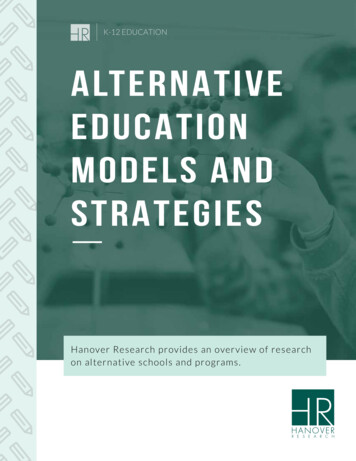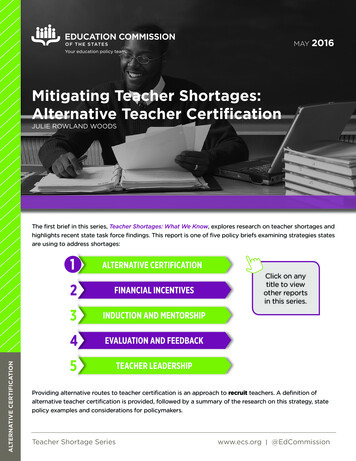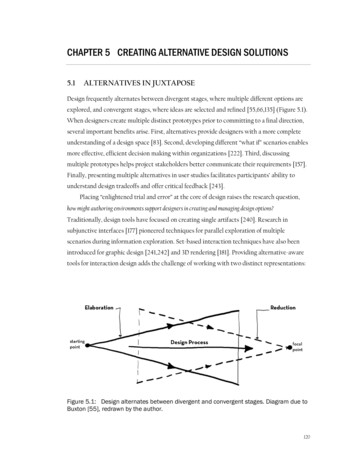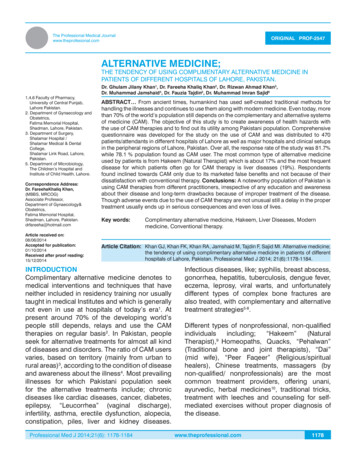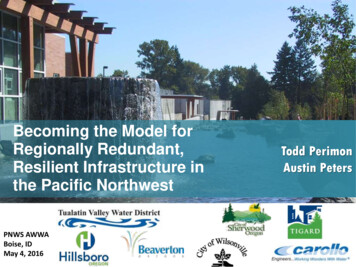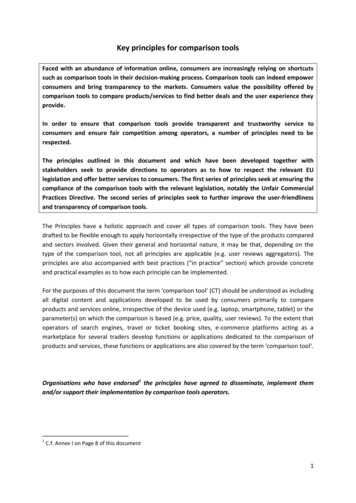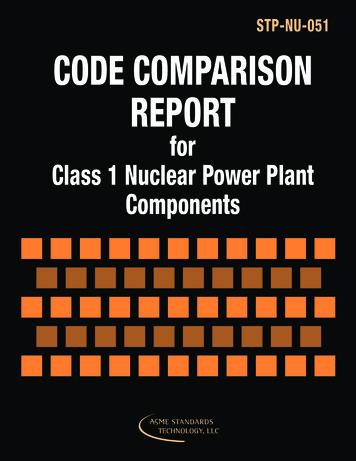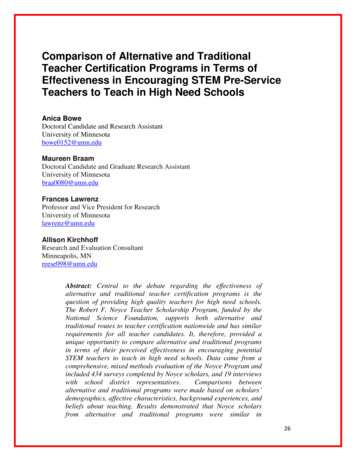
Transcription
Comparison of Alternative and TraditionalTeacher Certification Programs in Terms ofEffectiveness in Encouraging STEM Pre-ServiceTeachers to Teach in High Need SchoolsAnica BoweDoctoral Candidate and Research AssistantUniversity of Minnesotabowe0152@umn.eduMaureen BraamDoctoral Candidate and Graduate Research AssistantUniversity of Minnesotabraa0080@umn.eduFrances LawrenzProfessor and Vice President for ResearchUniversity of Minnesotalawrenz@umn.eduAllison KirchhoffResearch and Evaluation ConsultantMinneapolis, MNreese098@umn.eduAbstract: Central to the debate regarding the effectiveness ofalternative and traditional teacher certification programs is thequestion of providing high quality teachers for high need schools.The Robert F. Noyce Teacher Scholarship Program, funded by theNational Science Foundation, supports both alternative andtraditional routes to teacher certification nationwide and has similarrequirements for all teacher candidates. It, therefore, provided aunique opportunity to compare alternative and traditional programsin terms of their perceived effectiveness in encouraging potentialSTEM teachers to teach in high need schools. Data came from acomprehensive, mixed methods evaluation of the Noyce Program andincluded 434 surveys completed by Noyce scholars, and 19 interviewswith school district representatives.Comparisons betweenalternative and traditional programs were made based on scholars’demographics, affective characteristics, background experiences, andbeliefs about teaching. Results demonstrated that Noyce scholarsfrom alternative and traditional programs were similar in26
demographic and most affective characteristics but different inbackground experiences and beliefs about teaching. Moreover, thedata suggest that alternative routes might attract more candidateswho are more likely to teach in high need schools.Key Words: Alternative certification, traditional teacherpreparation, STEM teachers, high risk schools.There is a debate in the teacher certification literature regarding the effectivenessof alternative and traditional teacher certification programs in producing highly qualifiedteachers. Providing high quality teachers for high need schools is paramount for teachertraining programs because there is a lack of highly qualified teachers to staff theincreasing numbers of high need schools (Ingersoll, 2001, 2002). Several legislativeefforts have been proposed to help provide more highly qualified teachers for high needschools. Examples of these include a reauthorized Academic Improvement and TeacherQuality programs’ office and the allocation of specific funds to alternative certificationprograms. Both of these are under Title II, and part of the No Child Left Behind Act of2001 (No Child Left Behind Act, 2001). A third example is the America CreatingOpportunities to Meaningfully Promote Excellence in Technology, Education, andScience Act of 2007, which allocated funds to teachers intending to teach in high needsettings as well as to teacher certification programs for licensure in the specific contentareas of science, technology, engineering, and mathematics (STEM), and critical foreignlanguages (America COMPETES Act, 2007). A fourth example of a legislative effortoccurred in 2009, in which the National Science Foundation’s (NSF) Robert F. NoyceTeacher Scholarship Program (Noyce program) received specific funding under thestimulus package. The Noyce program commenced in 2002 and continues to providefunding for STEM teachers who are committed to teaching in high need schools for aspecified amount of time. The fact that all of these efforts support both alternative andtraditional teacher certification programs raises the question as to how differentalternative and traditional programs are in their effectiveness for preparing quality STEMteachers for high need schools. Importantly, if both types of programs are equallyeffective in providing quality teachers that meet the pedagogical, content knowledge, andpersonal affective characteristic requirements of high need schools, then perhaps becausealternative programs tend to be shorter and cost less, they might present a more efficientroute to teacher certification. Other major concerns exist within the alternative pathways,such as retention of teachers in high need schools.Both alternative and traditional certification programs have strong argumentssupporting their implementation. A literature review conducted by Legler (2002) foundthat the main supporting argument for alternative programs is that they require lesscoursework and requirements before becoming the teacher of record; thus they make theteaching profession more accessible to career changers and candidates who are interestedin teaching but do not have adequate funds to pay for prolonged education. Legler alsofound that alternative programs may increase the number of minority teachers, increasethe number of teachers in shortage areas, produce teachers that demonstrate similar27
classroom performance and student outcomes to traditionally certified teachers, andprovide intensive mentoring and support, which contributes to the development ofalternatively certified teachers.However, the main supporting argument for traditional certification programs isthat the extensive coursework, field experiences, and mentoring required beforebecoming the teacher of record produces teachers who are more qualified and confidentabout their preparedness to teach (Darling-Hammond, 2003). Similarly, Guyton, Fox, andSisk (1991) found that teachers who had completed traditional certification programswere perceived by principals and themselves as better prepared to teach than those whohad completed alternative certification programs. In addition, Darling-Hammond (1999)found that traditional certification programs seem to have higher entry and retention ratescompared to alternative certification programs and that they actually cost less whenconsidering the costs of certification, recruitment, induction, and replacement resultingfrom attrition.However, arguments can be made against both types of programs. Negativeaspects of alternative certification programs, summarized by Legler, are that alternativeprograms can allow unqualified people to assume total responsibility for classrooms; theygive inadequate attention to curriculum development, pedagogical knowledge, andclassroom management; and that their teacher candidates do not have the ability to learncontent knowledge “on-the-job”. Furthermore, alternative certification programs do notincrease the retention rate of teachers in comparison to traditional certification.The main argument against traditional programs is that their additionalrequirements do not necessarily provide teachers who are better prepared for theclassroom. For example, Hess (2001) drew attention to the fact that many traditionaleducation programs do not have a screening process like other academic programs suchas medicine or law, thus, they provide little protection against weak or incompetent preservice teachers who complete the teacher preparation regime. Finn (2003) pointed outthat alternative programs, such as Teach for America and Troops to Teachers, oftenprepare teachers who are just as capable inside the classroom as compared to others whowent through more “professional” teacher certification programs.To help elucidate the debate surrounding alternative and traditional teachercertification programs and to make more sound comparisons between the two, it isimportant to describe the characteristics and perceptions of preservice and in-serviceteachers who pass through these programs and determine any similarities and differencesbetween them. In particular, Hess’s argument cited above regarding strong versus weakteacher candidates entering the profession highlights the importance of determining whattype of teacher candidate each program attracts in order to make fairer comparisonsbetween alternative and traditional programs. Furthermore, in these comparisons, it isnecessary to pay particular attention to characteristics and perceptions that are known tobe important in teacher recruitment, retention, and attrition.28
It has been argued that studies comparing alternative and traditional programsmay have yielded contradictory results because there are variations in the definitions foralternative and traditional teacher certification programs (Miller, McKenna, & McKenna,1998; Tozer, O'Connell & Burstein, 2006). A commonly accepted definition foralternative programs is as follows:Alternative programs vary from short summer programs that placecandidates in teaching assignments with full responsibility for studentsafter a few weeks of training to those that offer 1- or 2-year postbaccalaureate programs with ongoing support, integrated coursework,close mentoring, and supervision. (Darling-Hammond, Chung, &Frelow, 2002, p. 287)A commonly accepted definition for traditional programs is as follows:Traditional programs are generally offered through a college ofeducation as four-year undergraduate degrees. A traditional teacherpreparation program curriculum typically combines subject matterinstruction, pedagogy classes, and field experience .Teachers intraining typically go through a period of student teaching, which isgenerally unpaid, and often are required to take a battery of assessmentsbefore they receive their degrees. (US Department of Education, Officeof Postsecondary Education, 2005, p. 6-7)Using these definitions as a guide and capitalizing on when the teacher candidatebecomes teacher of record, this study defined alternative programs as those that had theirteacher candidates become teacher of record before or during the first half of theircertification program. Accordingly, traditional programs were defined as those that thathad their teacher candidates become teacher of record after completing at least the firsthalf of their certification program due to limitations of the survey response options asdiscussed in the conclusion.The aim of this study was two-fold. The first was to compare teacher candidatesenrolled in alternative and traditional programs on certain personal characteristics thatpertained to their likelihood of being appropriate teachers in high need schools. Thesepersonal characteristics included sex, race/ethnicity, age, and affective characteristicsbecause they have all been determined to be important variables related to high needschools (Haberman, 1995; McKinney, Berry, Dickerson, & Campbell-Whately, 2007;Salinas, 2002). The likelihood of being a good teacher is also influenced by level ofcommitment to teaching (Haberman, 1995); therefore, the teacher candidates were alsocompared on their commitment to become teachers as well as their commitment to teachin a high need setting. The second purpose of this study was to compare the teachercandidates on their perceptions of the effectiveness of their programs in preparing themto teach in high need schools.29
Data for this study came from a comprehensive 4-year mixed methods evaluationof the Noyce program. The Noyce program is a nationwide teacher incentive-basedprogram funded by the NSF and is aimed towards supplying highly qualified STEMteachers to high need schools. For the purposes of this study, “highly qualified teacher”was defined as those possessing a strong content background and having gone through aquality certification program. Also, the term “high need” indicated that the school metat least one of the Title II requirements for either teacher attrition rates, percentage ofstudents eligible for free and reduced lunch, or percentage of teachers without a bacheloror graduate degree in the content area in which they did most of their teaching (No ChildLeft Behind, 2001).The Noyce program supplies highly qualified STEM teachers to high needschools by partnering with teacher certification programs nation-wide and providingfunding to teacher candidates. In turn, the teacher candidate fulfills a two-yearrequirement of teaching in a high need school for every year of support after completinghis or her certification program. Thus, the evaluation of the Noyce program provided aunique opportunity to examine the similarities and differences among scholars enrolledin alternative and traditional certification programs because all of the teachercertification programs the Noyce program partnered with (a) received funding, (b) hadsimilar high need teaching requirements of their candidates, and (c) selected only teachercandidates with high quality content knowledge in their proposed teaching area.Consistent with the aims of the study mentioned above, the two research questions were:1. How do teacher candidates enrolled in alternative and traditional programscompare on selected personal characteristics?2. How do these teacher candidates differ in their perceptions of their preparationprograms?Data CollectionData Sources and InstrumentsData were collected from three sources: the ORC Macro International, Inc.Noyce program monitoring database (ORC database), Noyce scholars using web-basedsurveys, and school district representatives using structured interviews.ORC database. The ORC database contained 1504 Noyce scholars, which isthe entire population of Noyce scholars during the reporting period from 2003-2007.Data found in the ORC database were provided by the principal investigators (PI) andwere entered during the 2003-2007 monitoring period. This database provided the sex,race, and content majors of the scholars.Scholar survey. The web-based scholar survey contained six sections. Itemsincluded questions about what influenced them to become teachers, and perceptionsabout their teacher certification programs. The survey was customized so that the itemswould be applicable to scholars in different stages of their careers (e.g., still enrolled as a30
student, graduated and teaching, etc.). Four hundred thirty four of the 555 surveyresponses could be matched with the ORC database and were used for this study.Factors identified on the survey. Due to the large number of items in thescholar survey (83 items), it was important to combine and reduce the survey items intofactor scores for analysis. Through a cross-validation study, exploratory factor analysis(EFA) and confirmatory factor analysis (CFA) were used to identify underlyingconceptual constructs/factors and create factor scores to represent the survey responses.More detailed information about the EFA and CFA procedures can be found in Kirchoff,Lawrenz, and Bowe (2010) and Bowe, Liu, and Lawrenz (2009).The EFA and CFA showed that the scholar survey contained eight factors thatmeasured some aspect of the scholars’ background experience, commitment to teaching,beliefs about teaching, and perceptions regarding the effectiveness of their certificationprograms. These factors were called: (a) influence of the Noyce program on scholars’commitment to become a teacher, (b) influence of the Noyce program on scholars’commitment to teach in a high need school, (c) preparation for high need schools, (d)path to teaching, (e) district/school high need environment, (f) personal beliefs towardsteaching, (g) school teaching environment, and (h) mentoring experience. Factor scoresfor these eight factors were created and used in the analyses. The factor scores werestandardized on a normal distribution with a mean of zero and a standard deviation ofone.Explanation of factors. The first factor, influence of the Noyce program onscholars’ commitment to become a teacher, included three items that measured thescholars’ perceived commitment to becoming teachers. The higher the score, the moreinfluence the scholars perceived the funding had on their decisions to enter the teachingprofession, therefore the less committed they were to becoming teachers before being apart of the Noyce program. The second factor, influence of the Noyce program onscholars’ commitment to teach in a high need school, included three items that measuredthe scholars’ perceived commitment to teaching in a high need school. The higher thescore, the more influence the scholars perceived the Noyce funding had on theirdecisions to teach in a high need school, therefore, the less committed they were toteaching in a high need school before being a part of the Noyce program.The third factor, preparation for high need schools, included the scholars’responses to 13 items regarding how prepared they felt for teaching in a high needschool. The higher the score, the more prepared scholars felt for teaching in high needschools. The fourth factor, path to teaching, included the scholars’ responses to sevenitems regarding various aspects of courses they took, at what time in their academic orcareer life they decided to become teachers, and their previous career status. The higherthe score, the older they were, the more STEM classes they would have taken, and themore likely they would have been career-changers. The fifth factor, districts/schoolshigh need status, included five items about the district/school high need status. Theseindicated scholars’ perceptions of the percentage of students receiving free or reducedlunch, the percentage of teachers lacking sufficient training in the academic area they do31
most of their teaching in, and the percentage of teacher attrition over the last three years.Higher scores corresponded to districts/schools meeting more Title II requirements forbeing considered high need.The sixth factor, personal beliefs towards teaching, included nine items to whichthe scholars responded. Higher scores corresponded to higher levels of job satisfaction,opportunities for professional growth, and higher self-efficacy towards teaching. Theseventh factor, school teaching environment, included five items regardingcollaboration, support, and the availability of materials at their schools. Higher scores onthis factor indicated that the scholars perceived their environment as being morecollaborative and supportive. Finally, for the eighth factor, mentoring experiences, thescholars were asked six questions regarding mentoring experiences they might havereceived during and after their teacher certification program. Higher scores for this finalfactor indicated that the scholars reported more mentoring experiences.School district interviews. Interviews were conducted with representativesfrom school districts that partnered with Noyce teacher certification programs. Therewere 19 district interviews conducted from January to July 2008 and these intervieweesrepresented 19 districts. The 19 interviewees held a variety of positions in the districts inwhich they were employed. Nine (47%) held positions in administration, such asprincipal, superintendent, human resource director, and assistant superintendent ofteaching and learning. Eight (42%) were employed as science or mathematicsspecialists, such as instructional coaches or content/curriculum supervisors. Theremaining two (11%) were high school science classroom teachers who were notmentors but district representatives for the Noyce program. The length of time involvedwith the Noyce program or scholars varied from one through six years. The interviewprotocol included questions regarding general background information, districtrepresentatives’ perceptions of Noyce scholars, hiring of Noyce scholars, mentoringpractices within districts and schools, knowledge of the Noyce program, and how theNoyce program has affected districts and districts’ relationships with the teachercertification institutions.Classification of Alternative and Traditional ProgramsThe Noyce program is situated nation-wide and partners with variousinstitutions; therefore, its scholars come from a number of alternative and traditionalprograms. Scholars were classified as belonging to either an alternative or a traditionalprogram based on the time they became the official teacher of record in the classroom.Scholars who became the teacher of record at the beginning, after a brief introduction tothe program, or during the first half of the program, were classified as attendingalternative programs, whereas those who became the teacher of record during the secondhalf or upon completion of their program were classified as attending traditionalprograms. With this classification scheme, 103 scholars were categorized as attendingalternative programs and 331 were categorized as attending traditional programs. The103 scholars were from 30 different alternative programs, and the 331 scholars werefrom 47 different traditional programs.32
AnalysesAll analyses included a quantitative or qualitative comparison of scholarsenrolled in alternative and traditional programs. Pearson’s Chi-square tests ofindependence were used for categorical data and independent t-tests were conducted forcontinuous data to compare the scholars on demographics, affective/personalcharacteristics, background experiences, level of commitment to becoming teachers,level of commitment to teaching in a high need school, beliefs about teaching, and theirperceptions regarding the effectiveness of their certification programs. Select variablesform the ORC database provided the demographic information, select items from thescholar survey measured their affective/personal characteristics and levels ofcommitment, and finally, the factor scores (for factors c through h) providedmeasurements on their background experiences, beliefs about teaching, and perceptionsof their certification programs. It should be noted that the results for factors a and b werenot reported because these factors were analogous to the survey items that measured thescholars’ levels of commitment. Due to the exploratory nature of this research, aBonferroni adjustment was not made on the family-wise error rate; thus, the alpha levelof significance for all tests remained at p .05.To analyze the qualitative interview data, coding completed using groundedtheory in the larger evaluation of the Noyce program were used to identify trendsbetween the two groups. The codes represented various findings, including districtperceptions of the affective characteristics of Noyce scholars. These perceptions werecompared for similarities and differences between the two groups.ResultsDemographicsThe Noyce scholars held various STEM content area majors. Overall, 39% of theNoyce scholars were mathematics majors, 52% were science majors, 5% were bothscience and mathematics majors, and 4% were engineering or technology majors. Thealternative and traditional programs were compared on four scholar demographics; sex,percent of minorities, age, and race/ethnicity (Table 1). Overall, the Noyce scholars were65% female and 35% male. Further, there were 68% white and 32% non-whiteparticipants. Chi-square tests revealed there was no difference in the distribution ofpercents between type of program and sex (1, N 434) 0.048, p .827, phi -.011) orrace ( 2(1, N 434) 0.375, p .540, phi .030). However, a student’s independentgroup comparison t-test revealed that scholars in alternative programs weresignificantly older (M 32.5yrs) than those in traditional programs (M 29.9yrs),t(148.5) 2.44, p .016, d .302.33
Table 1Age/Sex/Race/Ethnicity of the Noyce ScholarsAlternative TraditionalAge*32.5yrs29.9yrsFemale Male Ratio merican Indians0%1%Native ic8%9%Non-Hispanic69%63%Not reported23%27%Total103331Note. N 434. Numbers may not sum to 100% due torounding. Statistical analyses of the different groups werenot appropriate due to small sample sizes in some of thegroups. * p .05.Affective/Personal CharacteristicsOn the survey, the scholars were asked to indicate which affective/personalcharacteristics influenced them to become teachers. They were given a list of sevenchoices and asked to check all that applied. Figure 1 demonstrates that the four mostcommonly selected choices were that they liked working with young people, they felt asif teaching allowed them to “make a difference” in the world, they liked sharing theirsubject with others, and that they felt they had a talent for teaching STEM. Scholarsenrolled in alternative and traditional programs displayed similar patterns and there wereno statistical differences on any of these, suggesting that they shared similaraffective/personal characteristics that motivated them to become teachers.Interview data from district representatives were also analyzed for perceivedaffective characteristics of the Noyce scholars. Interviews were conducted with districtrepresentatives who partnered with either alternative programs or traditional programs.Counts of the codes were carried out to determine the degree to which they were more orless representative of alternative and traditional programs. If certain perceptions werecited at a fairly equal rate, it was interpreted as a similarity between scholars enrolled inalternative and traditional programs. Conversely, if certain perceptions were cited at a34
more disparate rate, then it was interpreted as a difference between the scholars. Theinterview data revealed that many of the district representatives’ perceptions of Noycescholars from alternative and traditional programs were similar. Comments pertaining toscholars from both types of programs were that they demonstrated maturity, were strongin their content knowledge, demonstrated leadership skills, and that they had a focusedpreparation in education. For example, interviewees were asked whether or not thetypical Noyce scholar was more or less attractive as a hire compared to any other newteacher. A district representative who partnered with an alternative program said:The candidates like the one we’re seeing this year, the one workingwith us, I have no questions about her content, it’s excellent. Andwe’re already thinking about offering her a position for next year. Theother thing is that she’s a proven commodity. She’s been workingwith our kids and we know that she can do it.Similarly, a district representative who partnered with a traditional program said:For sure more attractive. Because they’ve, they typically have a verystrong math/science background. So they’re typically more attractivein terms of their knowledge of math and science and theirunderstanding of how you can apply it in the real world.Figure 1. Affective/Personal characteristics of Noyce scholars,Alternative and TraditionalAlong with the similarities, the interview data also revealed three differences.Representatives who partnered with alternative programs more often stated that theywere receiving more minority and low-SES teaching candidates. For example, one35
representative said “Minority students that otherwise would not be able to afford the costof the education are involved.” Secondly, representatives partnering with alternativeprograms more often stated that their teaching candidates had more of a sense ofpurpose/mission/calling. The third difference was that representatives who partneredwith traditional programs more often suggested that their teaching candidates hadteacher preparation more focused on urban education. For example, one representativesaid:Well, when they sign the contract, they come in mentally prepared andcontent prepared to work with children in high needs areas. So all thetime that they are working on their certification they know what theend result will be. Working in a district with high needs students.A summary of the similarities and differences is presented in Figure 2. It shouldbe noted, however, that the district interviews represented only 12 teacher certificationprograms (five alternative, seven traditional) therefore any perceived qualitativedifferences between scholars enrolled in alternative and traditional programs may be dueto the strength of individual programs rather than alternative or traditional programstructure.KEY:Light grey circle – More often saidby district representatives whopartnered with traditional programsDark grey circles- More often saidby district representatives whopartnered with alternative programsWhite circles-Things said bydistrict representatives that werecommon to both alternative andtraditional programsFigure 2. Similarities and differences in district representatives’perceptions of Noyce scholars from alternative and traditional programs.36
Commitment to Becoming Teachers and Teaching in a High Need SchoolOn the survey instrument, there were two categorical items that served as proxiesfor measuring scholars’ commitment to becoming teachers and their commitment toteaching in a high need school, respectively. For these items, the scholars were asked toindicate “no”, “possibly”, or “yes” as to if they would have become teachers without theNoyce funding, and also if they would have taught in a high need school without theNoyce funding. If scholars indicated “yes”, they would have become teachers evenwithout the Noyce funding, this was interpreted as scholars having a higher commitmentto becoming teachers. Conversely, if the scholars indicated “no” or “possibly”, then thiswas interpreted as scholars possibly having a lower commitment to becoming teachers.The same interpretation held for the item measuring scholars’ commitment to teachingin a high need school. Figures 3 and 4 display the responses of the scholars to these twoitems. Overall, a visual inspection of the percentages for “no”, “possibly”, “yes” in bothfigures suggests that in general, the Noyce funding may have been more influential onscholars decisions to teach in high need school rather than in their decisions to becometeachers because in both groups the majority of the scholars indicated “yes” they wouldhave become teachers regardless of the Noyce funding. In contrast, less than 50% ofthem indicated they would have taught in a high need schools regardless of the Noy
alternative and traditional teacher certification programs is the question of providing high quality teachers for high need schools. The Robert F. Noyce Teacher Scholarship Program, funded by the National Science Foundation, supports both alternative and traditional routes to teacher certification nationwide and has similar

